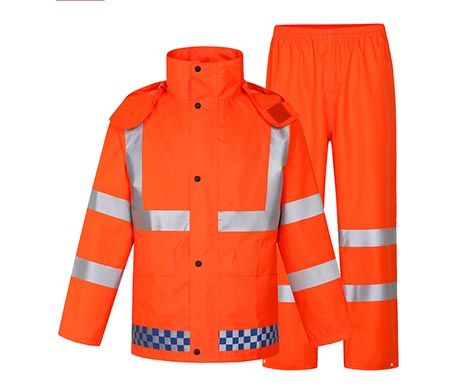Raincoats have evolved significantly over the years, not only in terms of design and functionality but also in the materials used for construction. When it comes to safety raincoats, the choice of material is crucial, as it directly impacts protection, comfort, and durability.
In this article, we'll delve into the different types of materials commonly used in safety raincoats and their respective advantages and disadvantages.
1. PVC (Polyvinyl Chloride)
PVC is a popular choice for safety raincoats due to its affordability and excellent waterproofing properties. These raincoats are typically lightweight and flexible, allowing for ease of movement. PVC raincoats often come with additional features such as reflective strips for increased visibility in low-light conditions, making them suitable for use in various work environments. However, PVC raincoats may lack breathability, leading to discomfort during prolonged wear.

2. PU (Polyurethane)
Polyurethane-coated raincoats offer similar waterproofing properties to PVC but with added breathability. This material allows moisture vapor to escape while preventing water from penetrating the fabric, keeping the wearer dry and comfortable. PU raincoats are often preferred for activities that require extended periods of wear, such as hiking or cycling. Additionally, PU-coated raincoats tend to be more environmentally friendly than PVC alternatives, as they do not contain chlorine.
3. Nylon
Nylon is a lightweight and durable material commonly used in safety raincoat construction. Nylon raincoats are known for their tear resistance and ability to withstand harsh weather conditions. These raincoats are often treated with a waterproof coating to enhance their performance in wet conditions. While nylon raincoats offer excellent protection against the elements, they may lack breathability compared to PU-coated alternatives.
4. Polyester
Polyester raincoats are another popular choice for safety apparel due to their durability and resistance to shrinking and wrinkling. Polyester is often combined with a waterproof coating to create raincoats that offer both protection and comfort. These raincoats are typically lightweight and easy to pack, making them ideal for travel and outdoor activities. However, polyester raincoats may not provide as much breathability as other materials, leading to potential discomfort during prolonged wear.
5. Gore-Tex
Gore-Tex is a high-performance material known for its exceptional waterproofing and breathability. Made from expanded polytetrafluoroethylene (ePTFE), Gore-Tex raincoats are highly durable and versatile, making them suitable for a wide range of outdoor activities. These raincoats feature a microporous membrane that allows moisture vapor to escape while preventing water from entering, keeping the wearer dry and comfortable in various weather conditions. While Gore-Tex raincoats tend to be more expensive than other options, their superior performance and longevity justify the investment for many outdoor enthusiasts and professionals.
When choosing a safety raincoat, it's essential to consider the materials used in its construction to ensure optimal protection, comfort, and durability. PVC, PU, nylon, polyester, and Gore-Tex are among the most common materials used in safety raincoat manufacturing, each with its unique advantages and disadvantages. Whether you prioritize affordability, breathability, or high-performance waterproofing, there's a safety raincoat material suited to your specific needs and preferences. By understanding the characteristics of different materials, you can make an informed decision and select the right raincoat for your intended use.
Copyright © Hebei Sinotools Industrial Co.,Ltd. All Rights Reserved | Powered by  Sitemap
Sitemap